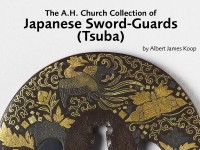The A. H. Church Collection of Japanese Sword-Guards (Tsuba)
An unpublished catalogue of the A. H. Church collection of Japanese sword-guards (tsuba) by Albert James Koop.

Early in the 17th century, tradition says, a dealer of Kiōto, named Kariganeya Hikobei, practised the designing of openwork iron guards in a new and refined style and had them made by a group of skilled craftsmen. From among these men he selected one Shōgunal capital, and settled with him at Kurokawa-dani in the Akasaka [Japanese text] district. Shōzayemon took the name of Tadamasa and continued his work on Kariganeya’s designs, dying in 1657. His son (or younger brother) Shōyemon, who succeeded him, calling himself Tadamasa II and adopting Akasaka as a surname, died in 1677 and was in turn succeeded by his son Masatora (d. 1707), by Masatora’s son Tadamune, and thence by four generations all called Tadatoki, the last living on into the middle of the 19th century. The first Tadatoki seems to have removed to Kiōto with his father’s pupil Tadashige and there to have founded a western branch of the school. Besides these a number of pupils, all called Tada-…, are recorded.
The earlier Akasaka guards closely resemble the pierced work of the Heianjō and Owari workers (Group III). Later productions display a number of striking features, such as clean-cut fret-piercing in positive silhouette of designs leaving little of the iron in reserve, the addition of a slight engraving finish, a rounded or rather tapered edge to the guard, and, in some of the more recent specimens, the semi-circular enlargement of each end of the tang-hole, as if to take a plug (not supplied) of abnormal size. Enrichments of other metals are entirely absent.
N.B. – Unless the contrary is stated, all guards in this group (1) are fret-pierced in positive silhouette, without either modelling or engraving finish, (2) have a rounded edge, and (3) are of 19th-century date.
As in the previous group, the phrase Bushū no jū occurring in some of the signatures is here contracted to BNJ.
 Round tsuba with triangle and flowers (EAX.10660)
Round tsuba with triangle and flowers (EAX.10660)
 Round tsuba with scrolls and aoi, or hollyhock leaves (EAX.10661)
Round tsuba with scrolls and aoi, or hollyhock leaves (EAX.10661)
 Round tsuba with floriated cusps (EAX.10662)
Round tsuba with floriated cusps (EAX.10662)
 Tsuba with matsukawa-bishi, or overlapping lozenges (EAX.10663)
Tsuba with matsukawa-bishi, or overlapping lozenges (EAX.10663)
 Tsuba with gosan-no-kiri, or paulownia leaves (EAX.10664)
Tsuba with gosan-no-kiri, or paulownia leaves (EAX.10664)
 Round tsuba with cusps (EAX.10665)
Round tsuba with cusps (EAX.10665)
 Tsuba with shippō diaper of interlaced circles (EAX.10665.a)
Tsuba with shippō diaper of interlaced circles (EAX.10665.a)
 Round tsuba oblongs, half-flowers, and weights (EAX.10666)
Round tsuba oblongs, half-flowers, and weights (EAX.10666)
 Tsuba with floral scrolls and Chinese flowers (EAX.10667)
Tsuba with floral scrolls and Chinese flowers (EAX.10667)
 Round tsuba with grass and karigane, or flying geese (EAX.10668)
Round tsuba with grass and karigane, or flying geese (EAX.10668)
 Lobed tsuba with overlapping loops (EAX.10669)
Lobed tsuba with overlapping loops (EAX.10669)
 Tsuba with chrysanthemoid border enclosing a cobweb shape (EAX.10670)
Tsuba with chrysanthemoid border enclosing a cobweb shape (EAX.10670)
 Tsuba with cherry blossoms (EAX.10671)
Tsuba with cherry blossoms (EAX.10671)
 Lenticular tsuba with chrysanthemum flowers (EAX.10672)
Lenticular tsuba with chrysanthemum flowers (EAX.10672)
 Tsuba with chrysanthemum flowers and leaves (EAX.10673)
Tsuba with chrysanthemum flowers and leaves (EAX.10673)
 Lenticular tsuba with diaper of overlapping chrysanthemum flowers and leaves (EAX.10674)
Lenticular tsuba with diaper of overlapping chrysanthemum flowers and leaves (EAX.10674)
 Tsuba with three cranes representing the mythical Mount Hōrai (EAX.10675)
Tsuba with three cranes representing the mythical Mount Hōrai (EAX.10675)
 Tsuba with characters representing the 12 animals of the Chinese zodiac (EAX.10676)
Tsuba with characters representing the 12 animals of the Chinese zodiac (EAX.10676)
 Tsuba with cherry blossoms floating on water (EAX.10677)
Tsuba with cherry blossoms floating on water (EAX.10677)
 Lenticular tsuba with parts of three mon (EAX.10678)
Lenticular tsuba with parts of three mon (EAX.10678)
 Tsuba with cherry blossoms (EAX.10679)
Tsuba with cherry blossoms (EAX.10679)
 Tsuba with mon formed from a clematis flower (EAX.10680)
Tsuba with mon formed from a clematis flower (EAX.10680)
 Tsuba with noshi, or auspicious abalone (EAX.10681)
Tsuba with noshi, or auspicious abalone (EAX.10681)
 Tsuba with paulownia leaves and flowers (EAX.10682)
Tsuba with paulownia leaves and flowers (EAX.10682)
 Tsuba with susuki grass and full moon (EAX.10683)
Tsuba with susuki grass and full moon (EAX.10683)
 Tsuba with three cranes (EAX.10684)
Tsuba with three cranes (EAX.10684)
 Lenticular tsuba with sagari-fuji mon (EAX.10685)
Lenticular tsuba with sagari-fuji mon (EAX.10685)
 Tsuba with 32 arrow feathers (EAX.10686)
Tsuba with 32 arrow feathers (EAX.10686)
 Tsuba with susuki grass and a cricket (EAX.10687)
Tsuba with susuki grass and a cricket (EAX.10687)
 Tsuba with susuki grass and a cricket (EAX.10688)
Tsuba with susuki grass and a cricket (EAX.10688)
 Aori-shaped tsuba with cryptomeria trees and silk reel (EAX.10689)
Aori-shaped tsuba with cryptomeria trees and silk reel (EAX.10689)
 Tsuba with heraldic hawk feathers and ground bamboo (EAX.10690)
Tsuba with heraldic hawk feathers and ground bamboo (EAX.10690)
 Tsuba with heraldic cherry blossoms (EAX.10691)
Tsuba with heraldic cherry blossoms (EAX.10691)
 Round tsuba with characters representing the 12 animals of the Chinese zodiac (EAX.10692)
Round tsuba with characters representing the 12 animals of the Chinese zodiac (EAX.10692)
 Tsuba with peony flowers (EAX.10693)
Tsuba with peony flowers (EAX.10693)
 Lenticular tsuba with peony flower (EAX.10694)
Lenticular tsuba with peony flower (EAX.10694)
 Lenticular tsuba with peony flower (EAX.10695)
Lenticular tsuba with peony flower (EAX.10695)
 Lenticular tsuba with stylized flowers (EAX.10696)
Lenticular tsuba with stylized flowers (EAX.10696)
 Tsuba with stylized flowers (EAX.10697)
Tsuba with stylized flowers (EAX.10697)
Notice
Object information may not accurately reflect the actual contents of the original publication, since our online objects contain current information held in our collections database. Click on 'buy this publication' to purchase printed versions of our online publications, where available, or contact the Jameel Study Centre to arrange access to books on our collections that are now out of print.
© 2013 University of Oxford - Ashmolean Museum




